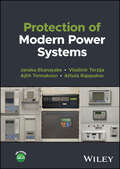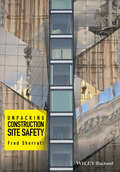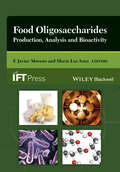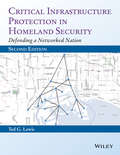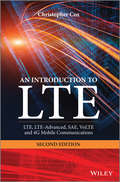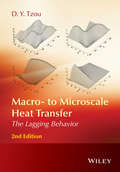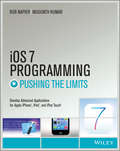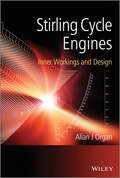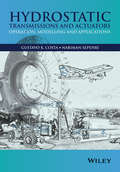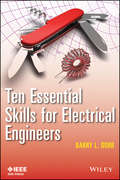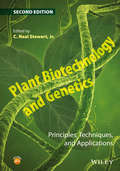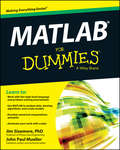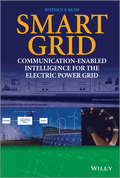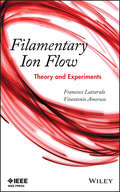- Table View
- List View
Protection of Modern Power Systems
by Janaka B. Ekanayake Vladimir Terzija Ajith Tennakoon Athula RajapakseProtection of Modern Power Systems Familiarize yourself with the cutting edge of power system protection technology All electrical systems are vulnerable to faults, whether produced by damaged equipment or the cumulative breakdown of insulation. Protection from these faults is therefore an essential part of electrical engineering, and the various forms of protection that have developed constitute a central component of any course of study related to power systems. Particularly in recent decades, however, the demands of decarbonization and reduced dependency on fossil fuels have driven innovation in the field of power systems. With new systems and paradigms come new kinds of faults and new protection needs, which promise to place power systems protection once again at the forefront of research and development. Protection of Modern Power Systems offers the first classroom-ready textbook to fully incorporate developments in renewable energy and ‘smart’ power systems into its overview of the field. It begins with a comprehensive guide to the principles of power system protection, before surveying the systems and equipment used in modern protection schemes, and finally discussing new and emerging protection paradigms. It promises to become the standard text in power system protection classrooms. Protection of Modern Power Systems readers will also find: Treatment of the new faults and protection paradigms produced by the introduction of new renewable generators Discussion of SmartGrids—intelligently-controlled active systems designed to integrate renewable energy into the power system—and their protection needs Detailed exploration of Synchronized Measurement Technology and Intelligent Electronic Devices Accompanying website to include Solutions Manual for instructors Protection of Modern Power Systems is an essential resource for students, researchers, and system engineers looking for a working knowledge of this critical subject.
Protection of Modern Power Systems
by Janaka B. Ekanayake Vladimir Terzija Ajith Tennakoon Athula RajapakseProtection of Modern Power Systems Familiarize yourself with the cutting edge of power system protection technology All electrical systems are vulnerable to faults, whether produced by damaged equipment or the cumulative breakdown of insulation. Protection from these faults is therefore an essential part of electrical engineering, and the various forms of protection that have developed constitute a central component of any course of study related to power systems. Particularly in recent decades, however, the demands of decarbonization and reduced dependency on fossil fuels have driven innovation in the field of power systems. With new systems and paradigms come new kinds of faults and new protection needs, which promise to place power systems protection once again at the forefront of research and development. Protection of Modern Power Systems offers the first classroom-ready textbook to fully incorporate developments in renewable energy and ‘smart’ power systems into its overview of the field. It begins with a comprehensive guide to the principles of power system protection, before surveying the systems and equipment used in modern protection schemes, and finally discussing new and emerging protection paradigms. It promises to become the standard text in power system protection classrooms. Protection of Modern Power Systems readers will also find: Treatment of the new faults and protection paradigms produced by the introduction of new renewable generators Discussion of SmartGrids—intelligently-controlled active systems designed to integrate renewable energy into the power system—and their protection needs Detailed exploration of Synchronized Measurement Technology and Intelligent Electronic Devices Accompanying website to include Solutions Manual for instructors Protection of Modern Power Systems is an essential resource for students, researchers, and system engineers looking for a working knowledge of this critical subject.
Unpacking Construction Site Safety
by Fred SherrattUnpacking Construction Site Safety provides a different perspective of safety in practice. • examines how useful the concept of safety actually is to the development of effective management interventions • providing new insights and information to the audience, and assist in a more informed development of new approaches in practice • aimed at safety and construction management practitioners as well as academics
Unpacking Construction Site Safety
by Fred SherrattUnpacking Construction Site Safety provides a different perspective of safety in practice. • examines how useful the concept of safety actually is to the development of effective management interventions • providing new insights and information to the audience, and assist in a more informed development of new approaches in practice • aimed at safety and construction management practitioners as well as academics
Food Oligosaccharides: Production, Analysis and Bioactivity (Institute of Food Technologists Series)
by F. Javier Moreno María Luz SanzA growing awareness of the relationship between diet and health has led to an increasing demand for food products that support health beyond simply providing basic nutrition. Digestive health is the largest segment of the burgeoning functional food market worldwide. Incorporation of bioactive oligosaccharides into foods can yield health benefits in the gastrointestinal tract and other parts of the body that are linked via the immune system. Because oligosaccharides can be added to a wide variety of foodstuffs, there is much interest within the food industry in incorporating these functional ingredients into healthy food products. Moreover, other areas such as pharmaceuticals, bioenergy and environmental science can exploit the physicochemical and physiological properties of bioactive oligosaccharides too. There is therefore a considerable demand for a concentrated source of information on the development and characterization of new oligosaccharides with novel and/or improved bioactivities. Food Oligosaccharides: Production, Analysis and Bioactivityis a comprehensive reference on the naturally occurring and synthesised oligosaccharides, which will enable food professionals to select and use these components in their products. It is divided into three sections: (i) Production and bioactivity of oligosaccharides, (ii) Analysis and (iii) Prebiotics in Food Formulation. The book addresses classical and advanced techniques to structurally characterize and quantitatively analyse food bioactive oligosaccharides. It also looks at practical issues faced by food industry professionals seeking to incorporate prebiotic oligosaccharides into food products, including the effects of processing on prebiotic bioavailability. This book is essential reading for food researchers and professionals, nutritionists and product developers working in the food industry, and students of Food Science with an interest in functional foods.
Food Oligosaccharides: Production, Analysis and Bioactivity (Institute of Food Technologists Series)
by F. Javier Moreno María Luz SanzA growing awareness of the relationship between diet and health has led to an increasing demand for food products that support health beyond simply providing basic nutrition. Digestive health is the largest segment of the burgeoning functional food market worldwide. Incorporation of bioactive oligosaccharides into foods can yield health benefits in the gastrointestinal tract and other parts of the body that are linked via the immune system. Because oligosaccharides can be added to a wide variety of foodstuffs, there is much interest within the food industry in incorporating these functional ingredients into healthy food products. Moreover, other areas such as pharmaceuticals, bioenergy and environmental science can exploit the physicochemical and physiological properties of bioactive oligosaccharides too. There is therefore a considerable demand for a concentrated source of information on the development and characterization of new oligosaccharides with novel and/or improved bioactivities. Food Oligosaccharides: Production, Analysis and Bioactivityis a comprehensive reference on the naturally occurring and synthesised oligosaccharides, which will enable food professionals to select and use these components in their products. It is divided into three sections: (i) Production and bioactivity of oligosaccharides, (ii) Analysis and (iii) Prebiotics in Food Formulation. The book addresses classical and advanced techniques to structurally characterize and quantitatively analyse food bioactive oligosaccharides. It also looks at practical issues faced by food industry professionals seeking to incorporate prebiotic oligosaccharides into food products, including the effects of processing on prebiotic bioavailability. This book is essential reading for food researchers and professionals, nutritionists and product developers working in the food industry, and students of Food Science with an interest in functional foods.
Critical Infrastructure Protection in Homeland Security: Defending a Networked Nation
by Ted G. Lewis PhD"...excellent for use as a text in information assurance or cyber-security courses...I strongly advocate that professors...examine this book with the intention of using it in their programs." (Computing Reviews.com, March 22, 2007) "The book is written as a student textbook, but it should be equally valuable for current practitioners...this book is a very worthwhile investment." (Homeland Security Watch, August 17, 2006) While the emphasis is on the development of policies that lead to successful prevention of terrorist attacks on the nation’s infrastructure, this book is the first scientific study of critical infrastructures and their protection. The book models the nation’s most valuable physical assets and infrastructure sectors as networks of nodes and links. It then analyzes the network to identify vulnerabilities and risks in the sector combining network science, complexity theory, modeling and simulation, and risk analysis. The most critical components become the focus of deeper analysis and protection. This approach reduces the complex problem of protecting water supplies, energy pipelines, telecommunication stations, Internet and Web networks, and power grids to a much simpler problem of protecting a few critical nodes. The new edition incorporates a broader selection of ideas and sectors and moves the mathematical topics into several appendices.
Critical Infrastructure Protection in Homeland Security: Defending a Networked Nation
by Ted G. Lewis"...excellent for use as a text in information assurance or cyber-security courses...I strongly advocate that professors...examine this book with the intention of using it in their programs." (Computing Reviews.com, March 22, 2007) "The book is written as a student textbook, but it should be equally valuable for current practitioners...this book is a very worthwhile investment." (Homeland Security Watch, August 17, 2006) While the emphasis is on the development of policies that lead to successful prevention of terrorist attacks on the nation’s infrastructure, this book is the first scientific study of critical infrastructures and their protection. The book models the nation’s most valuable physical assets and infrastructure sectors as networks of nodes and links. It then analyzes the network to identify vulnerabilities and risks in the sector combining network science, complexity theory, modeling and simulation, and risk analysis. The most critical components become the focus of deeper analysis and protection. This approach reduces the complex problem of protecting water supplies, energy pipelines, telecommunication stations, Internet and Web networks, and power grids to a much simpler problem of protecting a few critical nodes. The new edition incorporates a broader selection of ideas and sectors and moves the mathematical topics into several appendices.
An Introduction to LTE: LTE, LTE-Advanced, SAE, VoLTE and 4G Mobile Communications
by Christopher CoxFollowing on from the successful first edition (March 2012), this book gives a clear explanation of what LTE does and how it works. The content is expressed at a systems level, offering readers the opportunity to grasp the key factors that make LTE the hot topic amongst vendors and operators across the globe. The book assumes no more than a basic knowledge of mobile telecommunication systems, and the reader is not expected to have any previous knowledge of the complex mathematical operations that underpin LTE. This second edition introduces new material for the current state of the industry, such as the new features of LTE in Releases 11 and 12, notably coordinated multipoint transmission and proximity services; the main short- and long-term solutions for LTE voice calls, namely circuit switched fallback and the IP multimedia subsystem; and the evolution and current state of the LTE market. It also extends some of the material from the first edition, such as inter-operation with other technologies such as GSM, UMTS, wireless local area networks and cdma2000; additional features of LTE Advanced, notably heterogeneous networks and traffic offloading; data transport in the evolved packet core; coverage and capacity estimation for LTE; and a more rigorous treatment of modulation, demodulation and OFDMA. The author breaks down the system into logical blocks, by initially introducing the architecture of LTE, explaining thetechniques used for radio transmission and reception and the overall operation of the system, and concluding with more specialized topics such as LTE voice calls and the later releases of the specifications. This methodical approach enables readers to move on to tackle the specifications and the more advanced texts with confidence.
An Introduction to LTE: LTE, LTE-Advanced, SAE, VoLTE and 4G Mobile Communications
by Christopher CoxFollowing on from the successful first edition (March 2012), this book gives a clear explanation of what LTE does and how it works. The content is expressed at a systems level, offering readers the opportunity to grasp the key factors that make LTE the hot topic amongst vendors and operators across the globe. The book assumes no more than a basic knowledge of mobile telecommunication systems, and the reader is not expected to have any previous knowledge of the complex mathematical operations that underpin LTE. This second edition introduces new material for the current state of the industry, such as the new features of LTE in Releases 11 and 12, notably coordinated multipoint transmission and proximity services; the main short- and long-term solutions for LTE voice calls, namely circuit switched fallback and the IP multimedia subsystem; and the evolution and current state of the LTE market. It also extends some of the material from the first edition, such as inter-operation with other technologies such as GSM, UMTS, wireless local area networks and cdma2000; additional features of LTE Advanced, notably heterogeneous networks and traffic offloading; data transport in the evolved packet core; coverage and capacity estimation for LTE; and a more rigorous treatment of modulation, demodulation and OFDMA. The author breaks down the system into logical blocks, by initially introducing the architecture of LTE, explaining thetechniques used for radio transmission and reception and the overall operation of the system, and concluding with more specialized topics such as LTE voice calls and the later releases of the specifications. This methodical approach enables readers to move on to tackle the specifications and the more advanced texts with confidence.
Macro- to Microscale Heat Transfer: The Lagging Behavior
by D. Y. TzouPhysical processes taking place in micro/nanoscale strongly depend on the material types and can be very complicated. Known approaches include kinetic theory and quantum mechanics, non-equilibrium and irreversible thermodynamics, molecular dynamics, and/or fractal theory and fraction model. Due to innately different physical bases employed, different approaches may involve different physical properties in describing micro/nanoscale heat transport. In addition, the parameters involved in different approaches, may not be mutually inclusive. Macro- to Microscale Heat Transfer: The Lagging Behavior, Second Edition continues the well-received concept of thermal lagging through the revolutionary approach that focuses on the finite times required to complete the various physical processes in micro/nanoscale. Different physical processes in heat/mass transport imply different delay times, which are common regardless of the material type. The delay times, termed phase lags, are characteristics of materials. Therefore the dual-phase-lag model developed is able to describe eleven heat transfer models from macro to nanoscale in the same framework of thermal lagging. Recent extensions included are the lagging behavior in mass transport, as well as the nonlocal behavior in space, bearing the same merit of thermal lagging in time, in shrinking the ultrafast response down to the nanoscale. Key features: Takes a unified approach describing heat and mass transport from macro, micro to nanoscale Compares experimental results for model validation Includes easy to follow mathematical formulation Accompanied by a website hosting supporting material Macro- to Microscale Heat Transfer: The Lagging Behavior, Second Edition is a comprehensive reference for researchers and practitioners, and graduate students in mechanical, aerospace, biological and chemical engineering.
iOS 7 Programming Pushing the Limits: Develop Advance Applications for Apple iPhone, iPad, and iPod Touch (Pushing the Limits)
by Rob Napier Mugunth KumarGet ready to create killer apps for iPad and iPhone on the new iOS 7! With Apple's introduction of iOS 7, demand for developers who know the new iOS will be high. You need in-depth information about the new characteristics and capabilities of iOS 7, and that's what you'll find in this book. If you have experience with C or C++, this guide will show you how to create amazing apps for iPhone, iPad, and iPod touch. You'll also learn to maximize your programs for mobile devices using iPhone SDK 7.0. Advanced topics such as security services, running on multiple iPlatforms, and local networking with Core Bluetooth are also covered. Prepares experienced developers to create great apps for the newest version of Apple's iOS Thoroughly covers the serious capabilities of iOS 7; information you need in order to make your apps stand out Delves into advanced topics including how to control multitasking, security services, running apps on multiple iPlatforms and iDevices, enabling in-app purchases, advanced text layout, and building a core foundation Also covers REST, advanced GCD, internationalization and localization, and local networking with Core Bluetooth iOS 7 Programming: Pushing the Limits will help you develop applications that take full advantage of everything iOS 7 has to offer.
iOS 7 Programming Pushing the Limits: Develop Advance Applications for Apple iPhone, iPad, and iPod Touch (Pushing The Limits Ser.)
by Rob Napier Mugunth KumarGet ready to create killer apps for iPad and iPhone on the new iOS 7! With Apple's introduction of iOS 7, demand for developers who know the new iOS will be high. You need in-depth information about the new characteristics and capabilities of iOS 7, and that's what you'll find in this book. If you have experience with C or C++, this guide will show you how to create amazing apps for iPhone, iPad, and iPod touch. You'll also learn to maximize your programs for mobile devices using iPhone SDK 7.0. Advanced topics such as security services, running on multiple iPlatforms, and local networking with Core Bluetooth are also covered. Prepares experienced developers to create great apps for the newest version of Apple's iOS Thoroughly covers the serious capabilities of iOS 7; information you need in order to make your apps stand out Delves into advanced topics including how to control multitasking, security services, running apps on multiple iPlatforms and iDevices, enabling in-app purchases, advanced text layout, and building a core foundation Also covers REST, advanced GCD, internationalization and localization, and local networking with Core Bluetooth iOS 7 Programming: Pushing the Limits will help you develop applications that take full advantage of everything iOS 7 has to offer.
Stirling Cycle Engines: Inner Workings and Design
by Allan J. OrganSome 200 years after the original invention, internal design of a Stirling engine has come to be considered a specialist task, calling for extensive experience and for access to sophisticated computer modelling. The low parts-count of the type is negated by the complexity of the gas processes by which heat is converted to work. Design is perceived as problematic largely because those interactions are neither intuitively evident, nor capable of being made visible by laboratory experiment. There can be little doubt that the situation stands in the way of wider application of this elegant concept. Stirling Cycle Engines re-visits the design challenge, doing so in three stages. Firstly, unrealistic expectations are dispelled: chasing the Carnot efficiency is a guarantee of disappointment, since the Stirling engine has no such pretentions. Secondly, no matter how complex the gas processes, they embody a degree of intrinsic similarity from engine to engine. Suitably exploited, this means that a single computation serves for an infinite number of design conditions. Thirdly, guidelines resulting from the new approach are condensed to high-resolution design charts – nomograms. Appropriately designed, the Stirling engine promises high thermal efficiency, quiet operation and the ability to operate from a wide range of heat sources. Stirling Cycle Engines offers tools for expediting feasibility studies and for easing the task of designing for a novel application. Key features: Expectations are re-set to realistic goals. The formulation throughout highlights what the thermodynamic processes of different engines have in common rather than what distinguishes them. Design by scaling is extended, corroborated, reduced to the use of charts and fully Illustrated. Results of extensive computer modelling are condensed down to high-resolution Nomograms. Worked examples feature throughout. Prime movers (and coolers) operating on the Stirling cycle are of increasing interest to industry, the military (stealth submarines) and space agencies. Stirling Cycle Engines fills a gap in the technical literature and is a comprehensive manual for researchers and practitioners. In particular, it will support effort world-wide to exploit potential for such applications as small-scale CHP (combined heat and power), solar energy conversion and utilization of low-grade heat.
Stirling Cycle Engines: Inner Workings and Design
by Allan J. OrganSome 200 years after the original invention, internal design of a Stirling engine has come to be considered a specialist task, calling for extensive experience and for access to sophisticated computer modelling. The low parts-count of the type is negated by the complexity of the gas processes by which heat is converted to work. Design is perceived as problematic largely because those interactions are neither intuitively evident, nor capable of being made visible by laboratory experiment. There can be little doubt that the situation stands in the way of wider application of this elegant concept. Stirling Cycle Engines re-visits the design challenge, doing so in three stages. Firstly, unrealistic expectations are dispelled: chasing the Carnot efficiency is a guarantee of disappointment, since the Stirling engine has no such pretentions. Secondly, no matter how complex the gas processes, they embody a degree of intrinsic similarity from engine to engine. Suitably exploited, this means that a single computation serves for an infinite number of design conditions. Thirdly, guidelines resulting from the new approach are condensed to high-resolution design charts – nomograms. Appropriately designed, the Stirling engine promises high thermal efficiency, quiet operation and the ability to operate from a wide range of heat sources. Stirling Cycle Engines offers tools for expediting feasibility studies and for easing the task of designing for a novel application. Key features: Expectations are re-set to realistic goals. The formulation throughout highlights what the thermodynamic processes of different engines have in common rather than what distinguishes them. Design by scaling is extended, corroborated, reduced to the use of charts and fully Illustrated. Results of extensive computer modelling are condensed down to high-resolution Nomograms. Worked examples feature throughout. Prime movers (and coolers) operating on the Stirling cycle are of increasing interest to industry, the military (stealth submarines) and space agencies. Stirling Cycle Engines fills a gap in the technical literature and is a comprehensive manual for researchers and practitioners. In particular, it will support effort world-wide to exploit potential for such applications as small-scale CHP (combined heat and power), solar energy conversion and utilization of low-grade heat.
Hydrostatic Transmissions and Actuators: Operation, Modelling and Applications
by Gustavo Costa Nariman SepehriHydrostatic Transmissions and Actuators takes a pedagogical approach and begins with an overview of the subject, providing basic definitions and introducing fundamental concepts. Hydrostatic transmissions and hydrostatic actuators are then examined in more detail with coverage of pumps and motors, hydrostatic solutions to single-rod actuators, energy management and efficiency and dynamic response. Consideration is also given to current and emerging applications of hydrostatic transmissions and actuators in automobiles, mobile equipment, wind turbines, wave energy harvesting and airplanes. End of chapter exercises and real world industrial examples are included throughout and a companion website hosting a solution manual is also available. Hydrostatic Transmissions and Actuators is an up to date and comprehensive textbook suitable for courses on fluid power systems and technology, and mechatronics systems design.
Hydrostatic Transmissions and Actuators: Operation, Modelling and Applications
by Gustavo Costa Nariman SepehriHydrostatic Transmissions and Actuators takes a pedagogical approach and begins with an overview of the subject, providing basic definitions and introducing fundamental concepts. Hydrostatic transmissions and hydrostatic actuators are then examined in more detail with coverage of pumps and motors, hydrostatic solutions to single-rod actuators, energy management and efficiency and dynamic response. Consideration is also given to current and emerging applications of hydrostatic transmissions and actuators in automobiles, mobile equipment, wind turbines, wave energy harvesting and airplanes. End of chapter exercises and real world industrial examples are included throughout and a companion website hosting a solution manual is also available. Hydrostatic Transmissions and Actuators is an up to date and comprehensive textbook suitable for courses on fluid power systems and technology, and mechatronics systems design.
Ten Essential Skills for Electrical Engineers (Wiley - IEEE)
by Barry L. DorrThe book is a review of essential skills that an entry-level or experienced engineer must be able to demonstrate on a job interview and perform when hired. It will help engineers prepare for interviews by demonstrating application of basic principles to practical problems. Hiring managers will find the book useful because it defines a common ground between the student's academic background and the company's product or technology-specific needs, thereby allowing managers to minimize their risk when making hiring decisions. Ten Essential Skills contains a series of "How to" chapters. Each chapter realizes a goal, such as designing an active filter or designing a discrete servo. The primary value of these chapters, however, is that they apply engineering fundamentals to practical problems. The book is a handy reference for engineers in their first years on the job. Enables recent graduates in engineering to succeed in challenging technical interviews Written in an intuitive, easy-to-follow style for the benefit of busy students and employers Book focuses on the intersection between company-specific knowledge and engineering fundamentals Companion website includes interview practice problems and advanced material
Plant Biotechnology and Genetics: Principles, Techniques, and Applications
by C. Neal StewartFocused on basics and processes, this textbook teaches plant biology and agriculture applications with summary and discussion questions in each chapter. Updates each chapter to reflect advances / changes since the first edition, for example: new biotechnology tools and advances, genomics and systems biology, intellectual property issues on DNA and patents, discussion of synthetic biology tools Features autobiographical essays from eminent scientists, providing insight into plant biotechnology and careers Has a companion website with color images from the book and PowerPoint slides Links with author's own website that contains teaching slides and graphics for professors and students: http://bit.ly/2CI3mjp
Plant Biotechnology and Genetics: Principles, Techniques, and Applications
by C. Neal StewartFocused on basics and processes, this textbook teaches plant biology and agriculture applications with summary and discussion questions in each chapter. Updates each chapter to reflect advances / changes since the first edition, for example: new biotechnology tools and advances, genomics and systems biology, intellectual property issues on DNA and patents, discussion of synthetic biology tools Features autobiographical essays from eminent scientists, providing insight into plant biotechnology and careers Has a companion website with color images from the book and PowerPoint slides Links with author's own website that contains teaching slides and graphics for professors and students: http://bit.ly/2CI3mjp
MATLAB For Dummies
by Jim Sizemore John Paul MuellerPlot graphs, solve equations, and write code in a flash! If you work in a STEM field, chances are you'll be using MATLAB on a daily basis. MATLAB is a popular and powerful computational tool and this book provides everything you need to start manipulating and plotting your data. MATLAB has rapidly become the premier data tool, and MATLAB For Dummies is a comprehensive guide to the fundamentals. MATLAB For Dummies guides you through this complex computational language from installation to visualization to automation. Learn MATLAB's language fundamentals including syntax, operators, and data types Understand how to use the most important window in MATLAB – the Command Window Get the basics of linear algebra to get up and running with vectors, matrices, and hyperspace Automate your work with programming scripts and functions Plot graphs in 2D and 3D to visualize your data Includes a handy guide for MATLAB's functions and plotting routines MATLAB is an essential part of the analysis arsenal and MATLAB For Dummies provides clear, thorough guidance to get the most out of your data.
Smart Grid: Communication-Enabled Intelligence for the Electric Power Grid (Wiley - IEEE)
by Stephen F. BushThis book bridges the divide between the fields of power systems engineering and computer communication through the new field of power system information theory. Written by an expert with vast experience in the field, this book explores the smart grid from generation to consumption, both as it is planned today and how it will evolve tomorrow. The book focuses upon what differentiates the smart grid from the "traditional" power grid as it has been known for the last century. Furthermore, the author provides the reader with a fundamental understanding of both power systems and communication networking. It shows the complexity and operational requirements of the evolving power grid, the so-called "smart grid," to the communication networking engineer; and similarly, it shows the complexity and operational requirements for communications to the power systems engineer. The book is divided into three parts. Part One discusses the basic operation of the electric power grid, covering fundamental knowledge that is assumed in Parts Two and Three. Part Two introduces communications and networking, which are critical enablers for the smart grid. It also considers how communication and networking will evolve as technology develops. This lays the foundation for Part Three, which utilizes communication within the power grid. Part Three draws heavily upon both the embedded intelligence within the power grid and current research, anticipating how and where computational intelligence will be implemented within the smart grid. Each part is divided into chapters and each chapter has a set of questions useful for exercising the readers' understanding of the material in that chapter. Key Features: Bridges the gap between power systems and communications experts Addresses the smart grid from generation to consumption, both as it is planned today and how it will likely evolve tomorrow Explores the smart grid from the perspective of traditional power systems as well as from communications Discusses power systems, communications, and machine learning that all define the smart grid It introduces the new field of power system information theory
Smart Grid: Communication-Enabled Intelligence for the Electric Power Grid (Wiley - IEEE)
by Stephen F. BushThis book bridges the divide between the fields of power systems engineering and computer communication through the new field of power system information theory. Written by an expert with vast experience in the field, this book explores the smart grid from generation to consumption, both as it is planned today and how it will evolve tomorrow. The book focuses upon what differentiates the smart grid from the "traditional" power grid as it has been known for the last century. Furthermore, the author provides the reader with a fundamental understanding of both power systems and communication networking. It shows the complexity and operational requirements of the evolving power grid, the so-called "smart grid," to the communication networking engineer; and similarly, it shows the complexity and operational requirements for communications to the power systems engineer. The book is divided into three parts. Part One discusses the basic operation of the electric power grid, covering fundamental knowledge that is assumed in Parts Two and Three. Part Two introduces communications and networking, which are critical enablers for the smart grid. It also considers how communication and networking will evolve as technology develops. This lays the foundation for Part Three, which utilizes communication within the power grid. Part Three draws heavily upon both the embedded intelligence within the power grid and current research, anticipating how and where computational intelligence will be implemented within the smart grid. Each part is divided into chapters and each chapter has a set of questions useful for exercising the readers' understanding of the material in that chapter. Key Features: Bridges the gap between power systems and communications experts Addresses the smart grid from generation to consumption, both as it is planned today and how it will likely evolve tomorrow Explores the smart grid from the perspective of traditional power systems as well as from communications Discusses power systems, communications, and machine learning that all define the smart grid It introduces the new field of power system information theory
Filamentary Ion Flow: Theory and Experiments
by Francesco Lattarulo Vitantonio AmorusoPresents all-new laboratory-tested theory for calculating more accurate ionized electric fields to aid in designing high-voltage devices and its components Understanding and accurately calculating corona originated electric fields are important issues for scientists who are involved in electromagnetic and electrostatic studies. High-voltage dc lines and equipment, in particular, can generate ion flows that can give rise to environmental inconveniences. Filamentary Ion Flow: Theory and Experiments provides interdisciplinary theoretical arguments to attain a final model for computational electrostatics in the presence of flowing space charge. Based on years of extensive lab tests pertaining to the physical performance of unipolar corona ion flows, the book covers the enlarging of conventional electrostatic applications, which allows for some emerging and uncharted interests to be explored. Filamentary Ion Flow: Examines the theoretical discussions for creating a model of computational electrostatics involved with flowing space charges Presents new theory and experimental data based on extensive testing Offers potential design applications utilizing the theory Helps scientists who are involved in electromagnetic and electrostatic studies understand and accurately calculate corona originated ion flow fields Filamentary Ion Flow: Theory and Experiments is ideal for electrical engineers and research scientists interested in high-voltage technology, computational electrostatics, and electromagnetic theory.
Filamentary Ion Flow: Theory and Experiments
by Francesco Lattarulo Vitantonio AmorusoPresents all-new laboratory-tested theory for calculating more accurate ionized electric fields to aid in designing high-voltage devices and its components Understanding and accurately calculating corona originated electric fields are important issues for scientists who are involved in electromagnetic and electrostatic studies. High-voltage dc lines and equipment, in particular, can generate ion flows that can give rise to environmental inconveniences. Filamentary Ion Flow: Theory and Experiments provides interdisciplinary theoretical arguments to attain a final model for computational electrostatics in the presence of flowing space charge. Based on years of extensive lab tests pertaining to the physical performance of unipolar corona ion flows, the book covers the enlarging of conventional electrostatic applications, which allows for some emerging and uncharted interests to be explored. Filamentary Ion Flow: Examines the theoretical discussions for creating a model of computational electrostatics involved with flowing space charges Presents new theory and experimental data based on extensive testing Offers potential design applications utilizing the theory Helps scientists who are involved in electromagnetic and electrostatic studies understand and accurately calculate corona originated ion flow fields Filamentary Ion Flow: Theory and Experiments is ideal for electrical engineers and research scientists interested in high-voltage technology, computational electrostatics, and electromagnetic theory.
